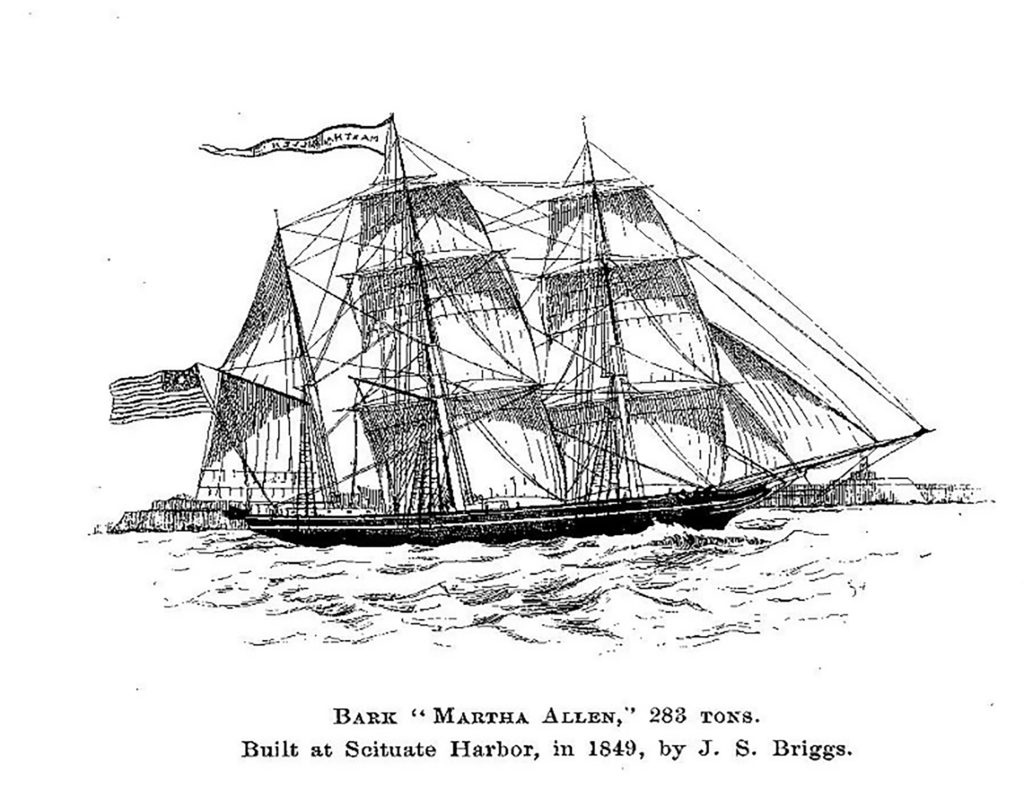December 19, 1919
By: Henry T. Claus
Transcribed and edited by Jane Estabrooks
Came to Boston’s Tea-Party
Another history-making ship that the North River gave to the nation was the brig Beaver, one of the vessels participating in Boston’s famous tea party on Dec. 16, 1773. The Beaver, tonnage unknown, was built by Ichabod Thomas at the Brick Kiln yard. On Dec. 1, 1773, she arrived in Boston with a cargo of tea which was unloaded in the unconventional way adopted by the patriotic Boston “longshoremen.” The men worked so rapidly that in the space of three hours they succeeded in breaking up and throwing overboard 342 chests, valued at nearly $100,000. This episode naturally put an abrupt end to the tea-carrying business and the Beaver, in company with other vessels, decided it was more lucrative to follow whaling. She sailed out of New Bedford for a year, when she went to England, where Captain Hezekiah Coffin died and the ship was sold. The Beaver’s life was a short but merry one.
First to Take Flag to England
The Brick Kiln yard, where the Beaver was built, also gave the Bedford to the world. In fact, at no other yard on the North River were so many famous vessels turned out and Ichabod Thomas, the builder, is one of the outstanding figures in little Pembroke’s history. The Bedford, let it be stated, took to herself the honor of being the first vessel to carry the Stars and Stripes into a British port. This vessel, of some 180 tons, was first rigged as a schooner, then changed to a brig, and finally rebuilt and rigged as a ship. Her first trip was to Philadelphia, where she went after a cargo of flour. The years 1776 and 1777 she spent in whaling and the next five years in the calm of Nantucket Harbor. When it was apparent that peace was coming with England, the far-sighted Quaker merchants saw a chance to steal a lap on their competitors and dispatched the Bedford to London where she arrived Feb. 6, 1782. Her appearance caused a considerable sensation and Customs House officers for some time were undecided what to do with her. An English journal of the day chronicled the event as follows:
 “The Bedford, Captain Moores, belonging to Massachusetts, arrived in the Downs on the 3rd of February passed the Gravesend the 4th and was reported at the Custom House the 6th inst. She was not allowed regular entry until some consultation had taken place between the Commissioners of the Customs and the Lords of the Council, on account of the many acts of Parliament yet in force against the rebels in America. She is loaded with 488 butts of whale oil, is American built, manned wholly by American seamen, wears the rebel colors, and belongs to the Island of Nantucket in Massachusetts. This is the first vessel which has displayed the 13 rebellious stripes in any British port. The vessel lies at Horsely Down, a little below the Tower and is intended immediately to return to New England.
“The Bedford, Captain Moores, belonging to Massachusetts, arrived in the Downs on the 3rd of February passed the Gravesend the 4th and was reported at the Custom House the 6th inst. She was not allowed regular entry until some consultation had taken place between the Commissioners of the Customs and the Lords of the Council, on account of the many acts of Parliament yet in force against the rebels in America. She is loaded with 488 butts of whale oil, is American built, manned wholly by American seamen, wears the rebel colors, and belongs to the Island of Nantucket in Massachusetts. This is the first vessel which has displayed the 13 rebellious stripes in any British port. The vessel lies at Horsely Down, a little below the Tower and is intended immediately to return to New England.
An American Challenge
That the relations between Americans and Englishmen were still a bit strained at the time, is indicated by a story told by Dr. Briggs. It seems that one of the crew of the Bedford was humpbacked. One day a British sailor met him, clapped his hand on the American’s shoulder and said, “Hello Jack, what have you got here?” “Bunker Hill and be damned to you.” Replied the Yankee. “Will you mount?”
Another notable product of the South Shore shipyards was the Maria, which was built in 1782 and sailed the seven seas for ninety years. So far as known, she was in service longer than any other vessel launched on the North River. She came from the yard of the famous Ichabod Thomas, and in her time touched at nearly every seaport of the globe – at the Falkland Islands in 1785; Greenland in 1788, and later as high on the ice as 79 degrees N. Designed as a privateer she was never used as such, most of her life being spent in the merchant business. She obtained considerable renown for making a voyage from Nantucket to Dover, England, in 21 days.
There are, of course, other famous North River ships. Nearly every one of the 1,000, indeed, did something or participated in some event which the conscientious chronicler hesitates to pass over. There was the Smyrna which won undying fame by first carrying the Stars and Stripes into the Black Sea; the ship Mount Vernon, displacing 464 tons and largest of all the North River vessels so large that it is still a mystery how she was ever gotten safely to the ocean; the Mattakeesett, 1830, the only steamboat built on the river.
To Be Continued. . . .
